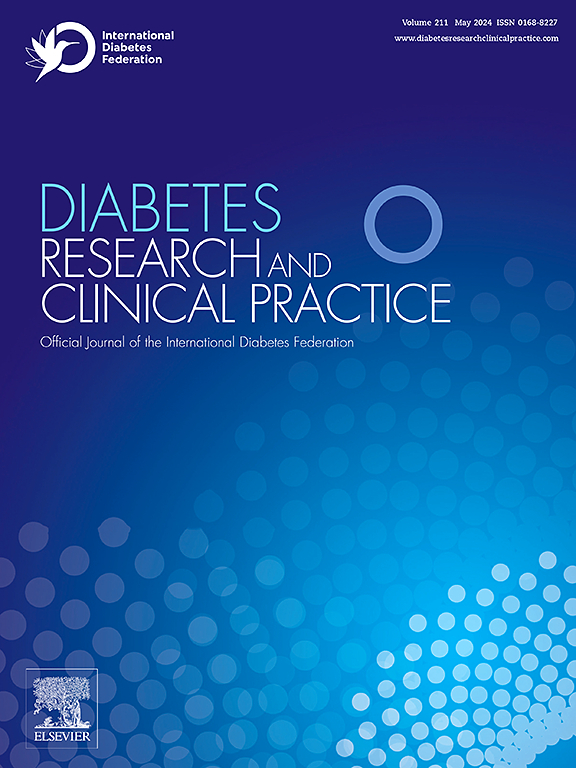Assessment of prevalence, risk factors, and psychosocial factors of gestational diabetes mellitus: A prospective observational study
IF 6.1
3区 医学
Q1 ENDOCRINOLOGY & METABOLISM
引用次数: 0
Abstract
Background
Gestational diabetes mellitus (GDM) is a significant public health problem due to its negative impacts on maternal and neonatal outcomes. The primary objective of this study was to determine the prevalence of GDM among pregnant women at a single tertiary care hospital and to identify the associated risk factors, including psychosocial stressors. Additionally, we aimed to classify the stressors to understand their relative impact.
Methods
We conducted a prospective observational study on 280 antenatal mothers from RIMS, Kadapa, between October 2023 and March 2024. We enrol participants according to standard diagnostic criteria, including and excluding them. GDM was diagnosed using a 75 g oral glucose tolerance test (OGTT) between 24–28 weeks of gestation. Participants were categorized into GDM (n = 60) and non-GDM (n = 220) groups. We evaluated psychosocial stress factors such as emotional burden, social support, and healthcare-related stress using a Gestational Diabetes Stress Scale (GDSS). Statistical analysis was performed using SPSS v20. Chi-square and t-tests were used to assess associations.
Results
The prevalence of GDM was 4.7 %. GDM was significantly associated with advanced maternal age (>35 years), pre-pregnancy BMI > 26 kg/m2, and a history of hypertension (p < 0.05). Multiparity (third pregnancy) was more common in the GDM group (33.3 %). Emotional burden (23.5 %) was the leading psychosocial stressor, followed by medication, lifestyle, social, and healthcare-related stress.
Conclusion
GDM is associated with both clinical and psychosocial factors. Advanced maternal age, obesity, and hypertension were major associated risk factors. The emotional burden significantly contributed to the overall stress in GDM patients. Integrating psychosocial screening into antenatal care could support better clinical outcomes.
评估妊娠期糖尿病的患病率、危险因素和社会心理因素:一项前瞻性观察研究
背景妊娠期糖尿病(GDM)是一个重大的公共卫生问题,因为它对孕产妇和新生儿的预后有负面影响。本研究的主要目的是确定一家三级医院孕妇中GDM的患病率,并确定相关的风险因素,包括社会心理压力源。此外,我们旨在对压力源进行分类,以了解它们的相对影响。方法我们对2023年10月至2024年3月期间来自Kadapa RIMS的280名产前母亲进行了前瞻性观察研究。我们根据标准诊断标准招募参与者,包括和排除他们。妊娠24-28周期间采用75 g口服葡萄糖耐量试验(OGTT)诊断GDM。参与者被分为GDM组(n = 60)和非GDM组(n = 220)。我们使用妊娠糖尿病压力量表(GDSS)评估心理社会压力因素,如情绪负担、社会支持和医疗相关压力。采用SPSS v20进行统计学分析。采用卡方检验和t检验来评估相关性。结果GDM患病率为4.7%。GDM与高龄产妇(35岁)、孕前BMI(35岁)显著相关。26 kg/m2,有高血压病史(p <;0.05)。多胎(第三次妊娠)在GDM组中更为常见(33.3%)。情绪负担(23.5%)是主要的心理社会压力源,其次是药物、生活方式、社会和卫生保健相关压力。结论糖尿病与临床和社会心理因素有关。高龄产妇、肥胖和高血压是主要的相关危险因素。情绪负担对GDM患者总体应激有显著影响。将社会心理筛查纳入产前保健可以支持更好的临床结果。
本文章由计算机程序翻译,如有差异,请以英文原文为准。
求助全文
约1分钟内获得全文
求助全文
来源期刊

Diabetes research and clinical practice
医学-内分泌学与代谢
CiteScore
10.30
自引率
3.90%
发文量
862
审稿时长
32 days
期刊介绍:
Diabetes Research and Clinical Practice is an international journal for health-care providers and clinically oriented researchers that publishes high-quality original research articles and expert reviews in diabetes and related areas. The role of the journal is to provide a venue for dissemination of knowledge and discussion of topics related to diabetes clinical research and patient care. Topics of focus include translational science, genetics, immunology, nutrition, psychosocial research, epidemiology, prevention, socio-economic research, complications, new treatments, technologies and therapy.
 求助内容:
求助内容: 应助结果提醒方式:
应助结果提醒方式:


